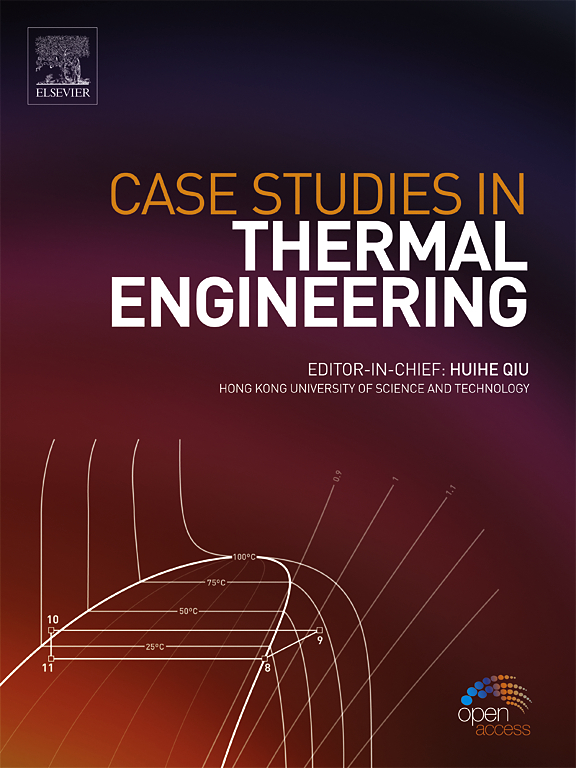用于发动机冷却的双管热交换器中新型振动圆柱涡轮的热摩擦分析
IF 6.4
2区 工程技术
Q1 THERMODYNAMICS
引用次数: 0
摘要
本研究的重点是通过采用新型振动圆柱形涡轮来提高大型内燃机冷却系统中使用的双管热交换器的热效率。实验调查检验了 1052 到 8430 之间的进气雷诺数,并评估了各种涡轮器配置,包括固定闭端式、固定开口式、振动闭端式和振动开口式圆柱涡轮器。此外,还分析了涡轮长度(从 10 厘米到 30 厘米不等)对热摩擦特性的影响。使用热增强因子(TEF)确定了最佳配置。结果表明,就传热和 TEF 而言,封闭式圆柱形涡轮明显优于开口式结构。虽然与固定式涡轮相比,振动式涡轮产生的压降更大,但它的传热率和 TEF 却高得多,因此成为热交换器的可行选择。研究还发现,增加涡轮长度可提高传热率、TEF 和压降。振动闭端圆柱形涡轮器的 TEF 值最大,其传热和压降分别比普通管式热交换器高出 385% 和 95%,完美的 TEF 值为 3.45。本文章由计算机程序翻译,如有差异,请以英文原文为准。
Thermal frictional analysis of a novel vibrating cylindrical turbulator in double tube heat exchangers for engine cooling
This study focuses on enhancing the thermal efficiency of a double-tube heat exchanger used in cooling systems for large-scale internal combustion engines by incorporating a novel vibrating cylindrical turbulator. The experimental investigation examined inlet Reynolds numbers ranging from 1052 to 8430 and evaluated various turbulator configurations, including fixed close-ended, fixed open-ended, vibrating close-ended, and vibrating open-ended cylindrical turbulators. Additionally, the impact of turbulator length, varying from 10 to 30 cm, on thermal-frictional characteristics was analyzed. The optimal configuration was determined using the thermal enhancement factor (TEF). Results showed that close-ended cylindrical turbulators significantly outperformed the open-ended configurations in terms of heat transfer and TEF. Although the vibrating turbulator produced a higher pressure drop compared to the fixed turbulator, it achieved a much higher heat transfer rate and TEF, making it a viable option for heat exchangers. The study also found that increasing the turbulator length leads to increased heat transfer, TEF, and pressure drop. The maximum TEF was recorded with the vibrating close-ended cylindrical turbulator, where heat transfer and pressure drop were up to 385 % and 95 % greater than those of a plain tube heat exchanger, respectively, resulting in a perfect TEF value of 3.45.
求助全文
通过发布文献求助,成功后即可免费获取论文全文。
去求助
来源期刊

Case Studies in Thermal Engineering
Chemical Engineering-Fluid Flow and Transfer Processes
CiteScore
8.60
自引率
11.80%
发文量
812
审稿时长
76 days
期刊介绍:
Case Studies in Thermal Engineering provides a forum for the rapid publication of short, structured Case Studies in Thermal Engineering and related Short Communications. It provides an essential compendium of case studies for researchers and practitioners in the field of thermal engineering and others who are interested in aspects of thermal engineering cases that could affect other engineering processes. The journal not only publishes new and novel case studies, but also provides a forum for the publication of high quality descriptions of classic thermal engineering problems. The scope of the journal includes case studies of thermal engineering problems in components, devices and systems using existing experimental and numerical techniques in the areas of mechanical, aerospace, chemical, medical, thermal management for electronics, heat exchangers, regeneration, solar thermal energy, thermal storage, building energy conservation, and power generation. Case studies of thermal problems in other areas will also be considered.
 求助内容:
求助内容: 应助结果提醒方式:
应助结果提醒方式:


